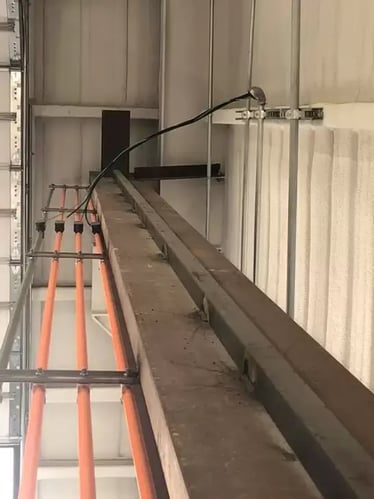-
PRODUCTSreturn
-
SERVICES AND PARTS
-
ABOUT US
Overhead crane clearances: Why and how to avoid problems
October 18, 2022
Overhead crane clearances: Why and how to avoid problems
3:26
Most of the people like surprises. Well… the nice surprises! But unexpected fees on an ongoing project is a bad surprise! Sometimes, big bills are the result of little details. When it comes to lifting equipment installations, a railway obstruction can lead to that kind of bad news. Let’s see how.
Standards
According to the CSA B167-16 standard, section 5.1.10, there should be “a minimum of 50 mm horizontal clearance and 75 mm overhead clearance from obstructions” when installing an overhead crane. While reading that requirement sounds logical, establishing a clearance standard on both side and top of a moving crane is the prudent course. But sometimes, a simple object installed on the wall or the ceiling, such as sprinklers or lighting, can cause an obstruction. Of course, your lifting solution specialist will consider that crucial factor.
Along comes the obstacle
But the bad surprise shows up! While installing your new overhead crane, your lifting specialist informs you that a modification is necessary. The curved rail part of a new garage door is blocking the overhead crane’s travel. Therefore, supplementary fees will be applied. That’s an unpleasant surprise, isn’t it? Shouldn’t the overhead crane supplier have known of that future installation based on the architect layout?

Figure 1 – a garage door blocks the lateral travel of the overhead crane.
In fact, not necessarily. We would normally assume that those accessories soon to be installed would be visible on the initial layout. But often though, it is not the case. The reason is that some of those devices or equipment are installed in a secondary phase of the project. So, when comes the date the overhead crane must be installed, the lifting company is facing a situation that they couldn’t have anticipated. They now must improvise a solution to be able to finish the installation, or even postpone it. But in both cases, an extra cost is more than likely. So how to avoid that kind of inconvenience?
Best practices to the rescue
Unfortunately, there is no ready-made solution, except being aware of that issue. So, by including this particular aspect of prevention in the management of a project, an owner would take a wise decision. Best practices would involve good communication between the stakeholders to reduce risks of cost-raising events. For example, a good idea would be to share a copy of the overhead crane layout to all the stakeholders, so they can consult it easily and be aware of what space the overhead crane really needs.
Here’s some accessories more likely to conflict with the travel of an overhead crane unexpectedly (non exhaustive):
- Garage door rails
- Sprinklers
- Lighting
- Drainpipes
- Standard or radiant heating units1
The unhindered installation
As we all know, there will always be unexpected situations that would disrupt even a well-prepared project. That is why the Premium Industrial Group, leader in lifting solution, can help you to reach the goal: a successful and unhindered installation!

Figure 2 – Just a bad decision… need we say more?!
1A radiant heating system often involves more than just a clearance to avoid obstruction. Since overhead crane components can be damaged by heat, additional accessories would be necessary, at additional cost too.
Learning Center
Whether you're an expert or know nothing about cranes, you'll find everything you need to know HERE.





